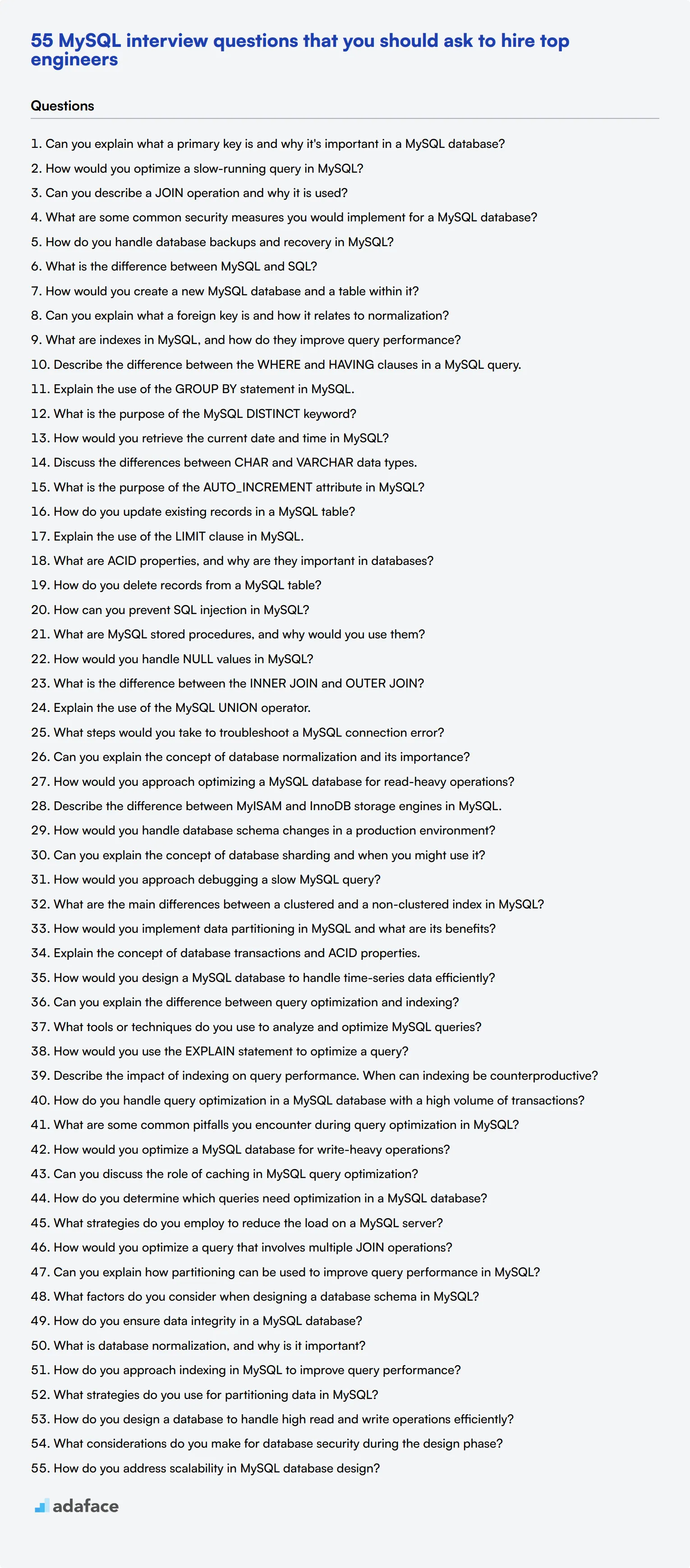Hiring the right MySQL developer can significantly impact your project's success and team productivity. Conducting effective interviews is key to identifying candidates with the necessary skills and knowledge for the role.
This blog post provides a comprehensive list of MySQL interview questions tailored for different experience levels, from junior to mid-tier developers. We'll cover general MySQL concepts, query optimization, and database design to help you assess candidates thoroughly.
By using these questions, you'll be able to evaluate applicants' MySQL proficiency and make informed hiring decisions. Consider complementing your interview process with a MySQL skills assessment to get a well-rounded view of candidates' abilities.
Table of contents
5 general MySQL interview questions and answers to assess applicants
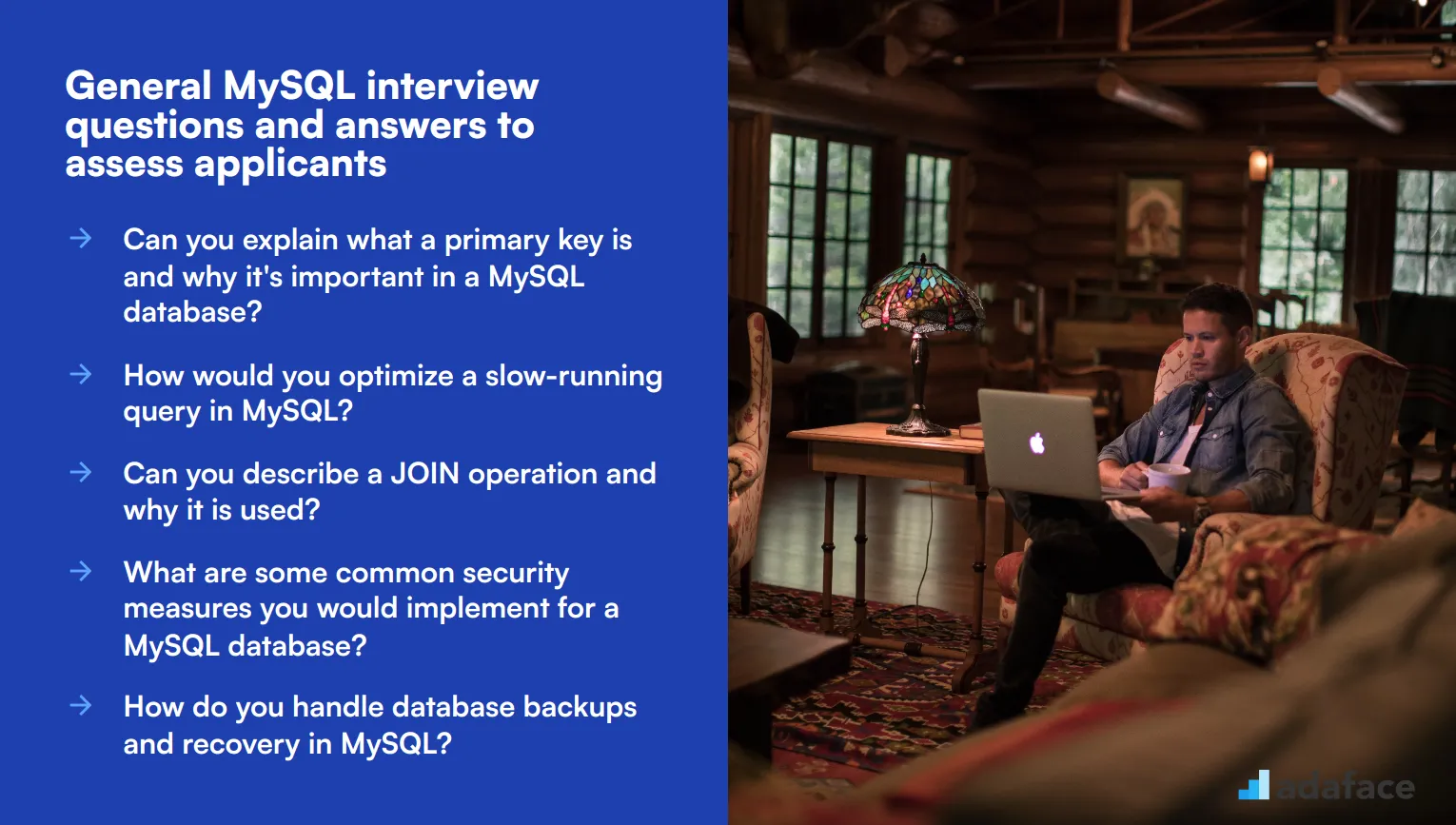
Use this list of MySQL interview questions to figure out if your applicants have the basic understanding and skills for working with MySQL databases. These questions are designed to keep your interviews focused on relevant knowledge without diving too deep into technical jargon.
1. Can you explain what a primary key is and why it's important in a MySQL database?
A primary key is a unique identifier for each record in a database table. It ensures that each record can be uniquely identified and helps maintain the integrity of the data.
Primary keys are crucial because they prevent duplicate entries and help speed up queries by providing a unique way to access each row in the table. In essence, they are the cornerstone of database indexing and efficiency.
Look for candidates who can clearly articulate the importance of primary keys and give examples of their use. This demonstrates their understanding of database structure and data integrity.
2. How would you optimize a slow-running query in MySQL?
Optimizing a slow query often involves analyzing and tweaking several aspects such as indexing, query structure, and server performance. Start with using the EXPLAIN command to understand how MySQL executes the query.
Common strategies include adding appropriate indexes, rewriting the query for efficiency, and ensuring the database schema is well-designed. Sometimes, hardware upgrades or server settings adjustments are necessary as well.
An ideal candidate should mention multiple optimization techniques and show they understand when and how to apply each one. Watch for practical examples from their past experience.
3. Can you describe a JOIN operation and why it is used?
A JOIN operation is used to combine rows from two or more tables based on a related column between them. There are several types of JOINs, such as INNER JOIN, LEFT JOIN, RIGHT JOIN, and FULL JOIN.
JOINs are essential in relational databases because they allow you to retrieve related data spread across multiple tables in a single query, making data analysis more efficient.
Candidates should be able to explain different types of JOINs and provide examples of when they would use each one. Their explanation should show a clear understanding of relational database concepts.
4. What are some common security measures you would implement for a MySQL database?
Common security measures include setting strong passwords, using SSL for encrypted connections, and implementing user roles and permissions to limit access to sensitive data.
Other important practices are regular software updates, database backups, and monitoring for unusual activities. Securing the network and server environment is also crucial to prevent unauthorized access.
Look for candidates who can discuss a range of security practices and explain why each is important. Their response should indicate a proactive approach to database security.
5. How do you handle database backups and recovery in MySQL?
Database backups in MySQL can be handled using tools like mysqldump for logical backups or by using physical backup methods like copying data files directly. Automating backups and ensuring they are stored securely is also key.
For recovery, you need to have a well-documented plan that includes steps for different types of failures, such as complete database loss or data corruption. Regularly testing backup and recovery procedures is essential.
Candidates should highlight their experience with both backup and recovery processes and mention any tools or scripts they have used. Their answer should convey reliability and thoroughness in managing data.
20 MySQL interview questions to ask junior developers
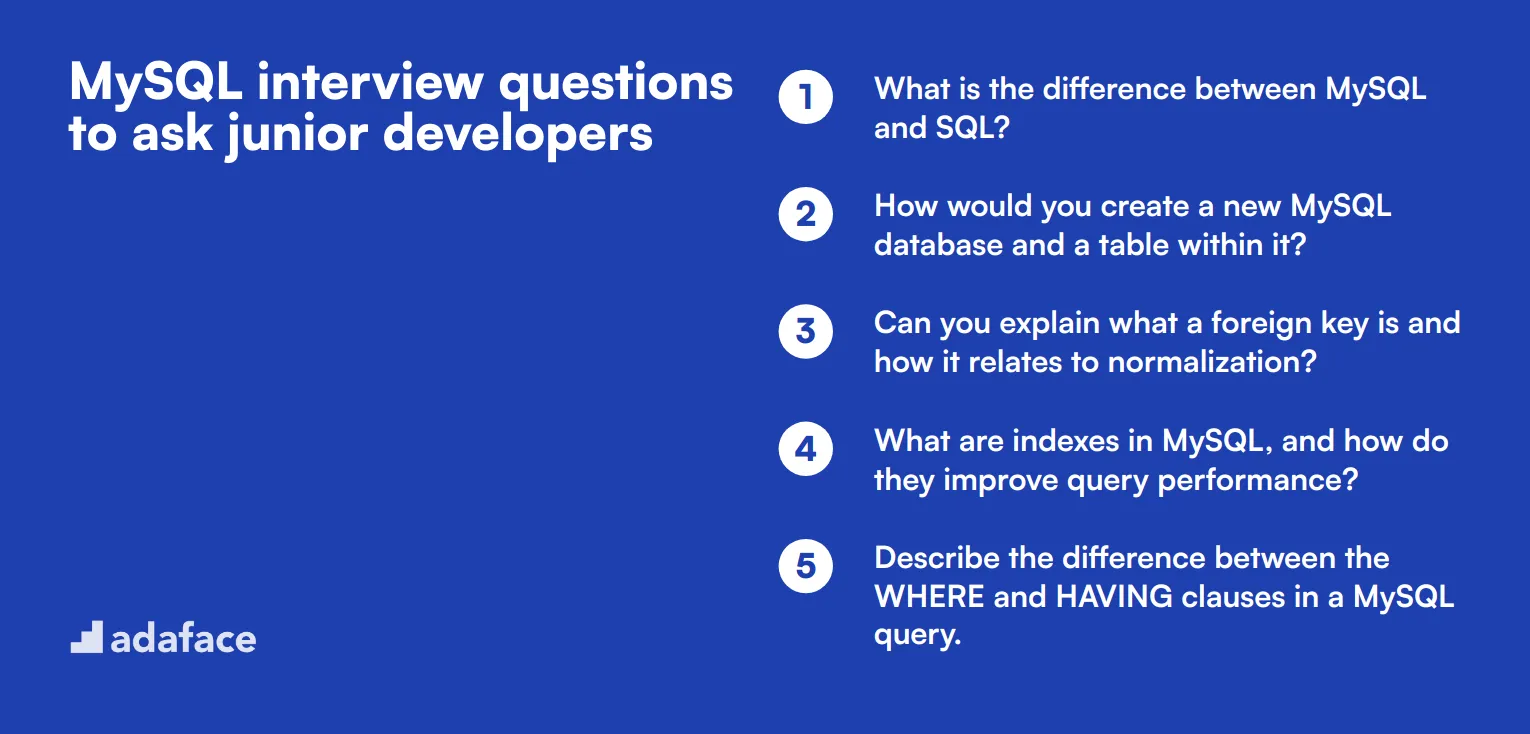
To gauge whether junior developers possess the foundational knowledge necessary for working with MySQL, consider utilizing this curated list of interview questions. These questions are tailored to help you assess their technical skills and problem-solving abilities, ensuring they can handle the fundamental tasks required for a MySQL Developer role effectively.
- What is the difference between MySQL and SQL?
- How would you create a new MySQL database and a table within it?
- Can you explain what a foreign key is and how it relates to normalization?
- What are indexes in MySQL, and how do they improve query performance?
- Describe the difference between the WHERE and HAVING clauses in a MySQL query.
- Explain the use of the GROUP BY statement in MySQL.
- What is the purpose of the MySQL DISTINCT keyword?
- How would you retrieve the current date and time in MySQL?
- Discuss the differences between CHAR and VARCHAR data types.
- What is the purpose of the AUTO_INCREMENT attribute in MySQL?
- How do you update existing records in a MySQL table?
- Explain the use of the LIMIT clause in MySQL.
- What are ACID properties, and why are they important in databases?
- How do you delete records from a MySQL table?
- How can you prevent SQL injection in MySQL?
- What are MySQL stored procedures, and why would you use them?
- How would you handle NULL values in MySQL?
- What is the difference between the INNER JOIN and OUTER JOIN?
- Explain the use of the MySQL UNION operator.
- What steps would you take to troubleshoot a MySQL connection error?
10 intermediate MySQL interview questions and answers to ask mid-tier developers.
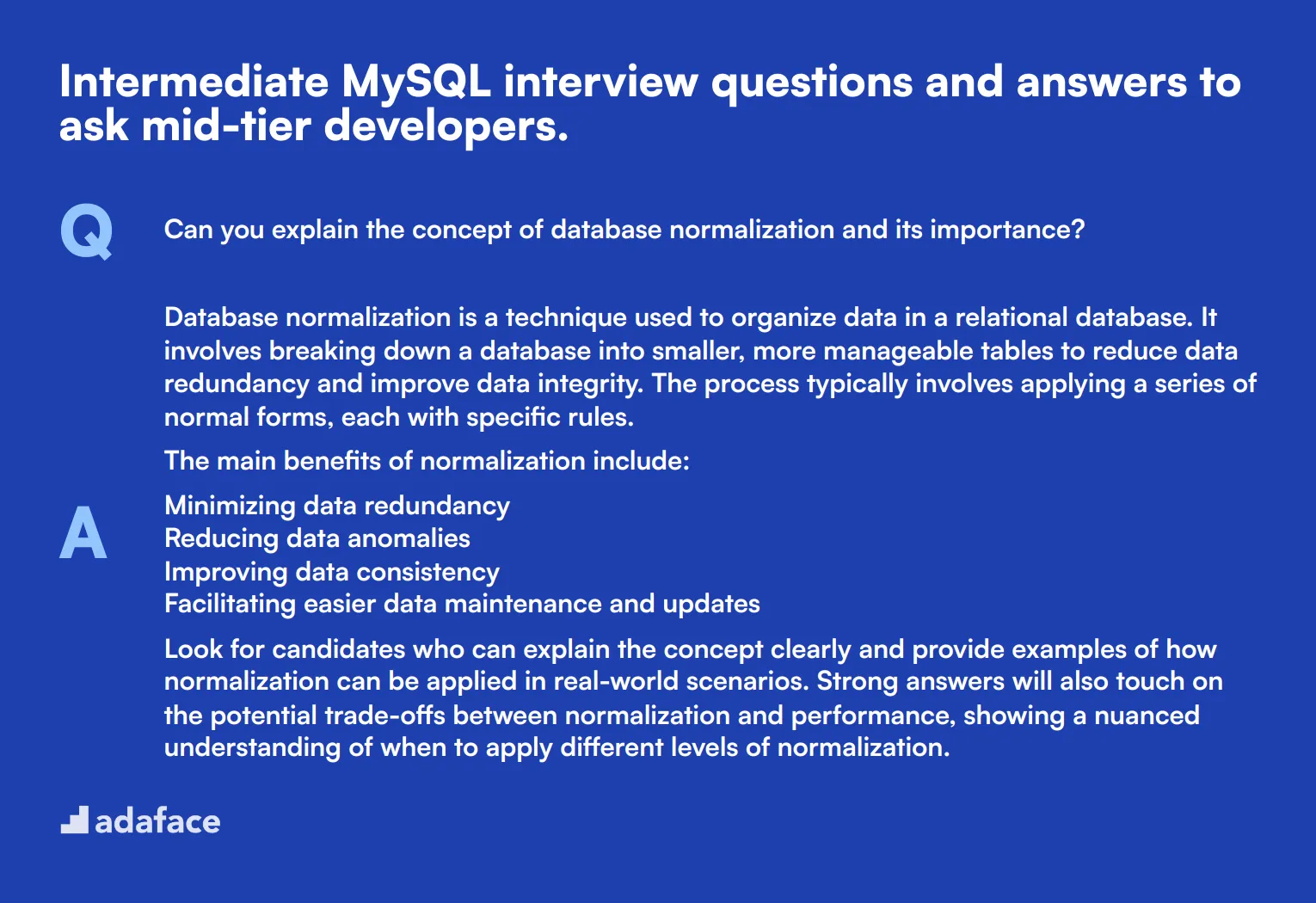
Ready to dive into the world of MySQL with your mid-tier developer candidates? These 10 intermediate questions will help you gauge their understanding of database concepts and practical skills. Use this list to assess the skills of your potential MySQL developers and identify those who can navigate the waters between basic and advanced database management.
1. Can you explain the concept of database normalization and its importance?
Database normalization is a technique used to organize data in a relational database. It involves breaking down a database into smaller, more manageable tables to reduce data redundancy and improve data integrity. The process typically involves applying a series of normal forms, each with specific rules.
The main benefits of normalization include:
- Minimizing data redundancy
- Reducing data anomalies
- Improving data consistency
- Facilitating easier data maintenance and updates
Look for candidates who can explain the concept clearly and provide examples of how normalization can be applied in real-world scenarios. Strong answers will also touch on the potential trade-offs between normalization and performance, showing a nuanced understanding of when to apply different levels of normalization.
2. How would you approach optimizing a MySQL database for read-heavy operations?
When optimizing a MySQL database for read-heavy operations, there are several strategies a candidate might suggest:
- Implementing proper indexing on frequently queried columns
- Using query caching to store results of frequent queries
- Employing read replicas to distribute read traffic
- Considering denormalization for certain data to reduce joins
- Utilizing in-memory databases or caching systems like Redis for frequently accessed data
A strong answer should demonstrate an understanding of the trade-offs between different optimization techniques. For example, while indexing can greatly improve read performance, it can also slow down write operations and increase storage requirements.
Look for candidates who can explain their reasoning behind each suggestion and show an awareness of how these optimizations might impact the overall system performance and maintenance.
3. Describe the difference between MyISAM and InnoDB storage engines in MySQL.
MyISAM and InnoDB are two popular storage engines in MySQL, each with its own characteristics:
MyISAM:
- Faster for read-heavy operations
- Supports table-level locking
- Does not support transactions
- Doesn't enforce referential integrity (foreign keys)
InnoDB:
- Supports row-level locking, allowing better concurrency
- Supports transactions and foreign key constraints
- Provides better crash recovery
- Generally preferred for write-intensive applications
A strong answer should not only list these differences but also provide context on when to use each engine. For example, a candidate might suggest using MyISAM for read-only or read-mostly tables in a data warehouse, while recommending InnoDB for transactional systems like e-commerce platforms. Look for answers that demonstrate an understanding of how these engines impact database performance and data integrity in real-world scenarios.
4. How would you handle database schema changes in a production environment?
Handling database schema changes in a production environment requires careful planning and execution. A good approach might include:
- Planning the changes and creating a rollback plan
- Testing the changes in a staging environment
- Backing up the production database
- Scheduling the changes during low-traffic periods
- Using tools like pt-online-schema-change for large tables to minimize downtime
- Implementing the changes incrementally if possible
- Monitoring the system closely after the changes
Strong candidates should emphasize the importance of minimizing downtime and ensuring data integrity throughout the process. They might also mention version control for database schemas and the use of database migration tools.
Look for answers that demonstrate an understanding of the risks involved in schema changes and the ability to mitigate these risks. Candidates should show awareness of the potential impact on application performance and the importance of clear communication with the development and operations teams during the process.
5. Can you explain the concept of database sharding and when you might use it?
Database sharding is a technique used to horizontally partition data across multiple databases or servers. It involves breaking a large database into smaller, more manageable pieces called shards. Each shard contains a subset of the data, typically based on a shard key.
Reasons to use sharding include:
- Improving database performance by distributing the load
- Scaling out to handle larger datasets
- Increasing availability and fault tolerance
- Overcoming hardware limitations of a single server
Look for candidates who can explain the benefits and challenges of sharding. They should mention that while sharding can greatly improve scalability, it also introduces complexity in terms of data distribution, query routing, and maintaining data consistency across shards. Strong answers might also touch on different sharding strategies (e.g., range-based, hash-based) and discuss scenarios where sharding might be appropriate versus other scaling techniques.
6. How would you approach debugging a slow MySQL query?
Debugging a slow MySQL query typically involves a systematic approach:
- Use EXPLAIN to analyze the query execution plan
- Check for proper indexing on columns used in WHERE, JOIN, and ORDER BY clauses
- Look for full table scans or large temporary tables in the EXPLAIN output
- Use the slow query log to identify problematic queries
- Analyze the query structure for inefficiencies (e.g., unnecessary JOINs, subqueries)
- Check for appropriate use of LIMIT and pagination
- Consider query rewriting or restructuring if necessary
Strong candidates might also mention using tools like MySQL Workbench or third-party performance monitoring tools to analyze query performance. They should emphasize the importance of testing changes in a non-production environment before applying them to production.
Look for answers that demonstrate a methodical approach to problem-solving and a deep understanding of MySQL query optimization techniques. Candidates should show awareness that query performance can be affected by various factors, including database design, indexing strategy, and the specific data distribution in the tables involved.
7. What are the main differences between a clustered and a non-clustered index in MySQL?
In MySQL, the main differences between clustered and non-clustered indexes are:
Clustered Index:
- Determines the physical order of data in a table
- Only one clustered index per table
- Typically faster for range queries
- In InnoDB, the primary key is always the clustered index
- Directly stores the row data
Non-Clustered Index:
- Does not affect the physical order of data
- Multiple non-clustered indexes allowed per table
- Contains a pointer to the data rather than the data itself
- Slightly slower for retrieving data compared to clustered indexes
- Useful for columns frequently used in WHERE clauses or JOINs
Look for candidates who can explain these differences clearly and provide examples of when to use each type of index. Strong answers might also discuss the impact of these indexes on insert, update, and delete operations, as well as their effect on storage requirements. Candidates should demonstrate an understanding of how the choice between clustered and non-clustered indexes can affect query performance and database design decisions.
8. How would you implement data partitioning in MySQL and what are its benefits?
Data partitioning in MySQL involves dividing large tables into smaller, more manageable pieces called partitions. It can be implemented using various methods:
- Range Partitioning: Based on ranges of column values
- List Partitioning: Based on lists of column values
- Hash Partitioning: Using a hash function on the column value
- Key Partitioning: Similar to hash partitioning, but MySQL manages the hashing
Benefits of partitioning include:
- Improved query performance, especially for large tables
- Easier management of large datasets
- Ability to archive old data by moving specific partitions
- Enhanced backup and recovery operations
- Potential for better distribution of I/O
Look for candidates who can explain the different partitioning methods and their appropriate use cases. Strong answers should also address potential drawbacks, such as increased complexity in query optimization and limitations on foreign keys. Candidates should demonstrate an understanding of how partitioning can be used to solve specific performance or management challenges in large-scale database systems.
9. Explain the concept of database transactions and ACID properties.
A database transaction is a sequence of one or more SQL operations that are treated as a single unit of work. The ACID properties ensure the reliability and consistency of database transactions:
- Atomicity: All operations in a transaction succeed or they all fail (roll back)
- Consistency: The database remains in a consistent state before and after the transaction
- Isolation: Concurrent transactions do not interfere with each other
- Durability: Once a transaction is committed, its effects are permanent
Strong candidates should be able to explain each ACID property with examples. They might discuss transaction isolation levels (Read Uncommitted, Read Committed, Repeatable Read, Serializable) and their implications for concurrency and data consistency. Look for answers that demonstrate an understanding of how ACID properties contribute to data integrity and how they might impact system performance. Candidates should also be aware of scenarios where strict ACID compliance might be relaxed for performance reasons, such as in certain NoSQL systems.
10. How would you design a MySQL database to handle time-series data efficiently?
Designing a MySQL database for time-series data requires careful consideration of data structure and query patterns. Key strategies might include:
- Using a appropriate data types (e.g., TIMESTAMP for time values)
- Implementing table partitioning by time ranges
- Creating indexes on timestamp columns and any frequently queried fields
- Considering data retention policies and implementing automated archiving
- Using summary tables for aggregated data to improve query performance
- Optimizing for append-only operations, which are common in time-series data
Advanced candidates might mention:
- Using columnar storage engines for analytical queries
- Implementing a hybrid solution with MySQL for recent data and specialized time-series databases for historical data
- Considering data compression techniques to reduce storage requirements
Look for answers that demonstrate an understanding of the unique challenges posed by time-series data, such as high write volumes and the need for efficient range queries. Strong candidates should be able to discuss trade-offs between different design choices and how they align with specific use cases (e.g., IoT data, financial trading, system monitoring). They should also show awareness of MySQL's capabilities and limitations when dealing with large volumes of time-series data.
12 MySQL questions related to query optimization
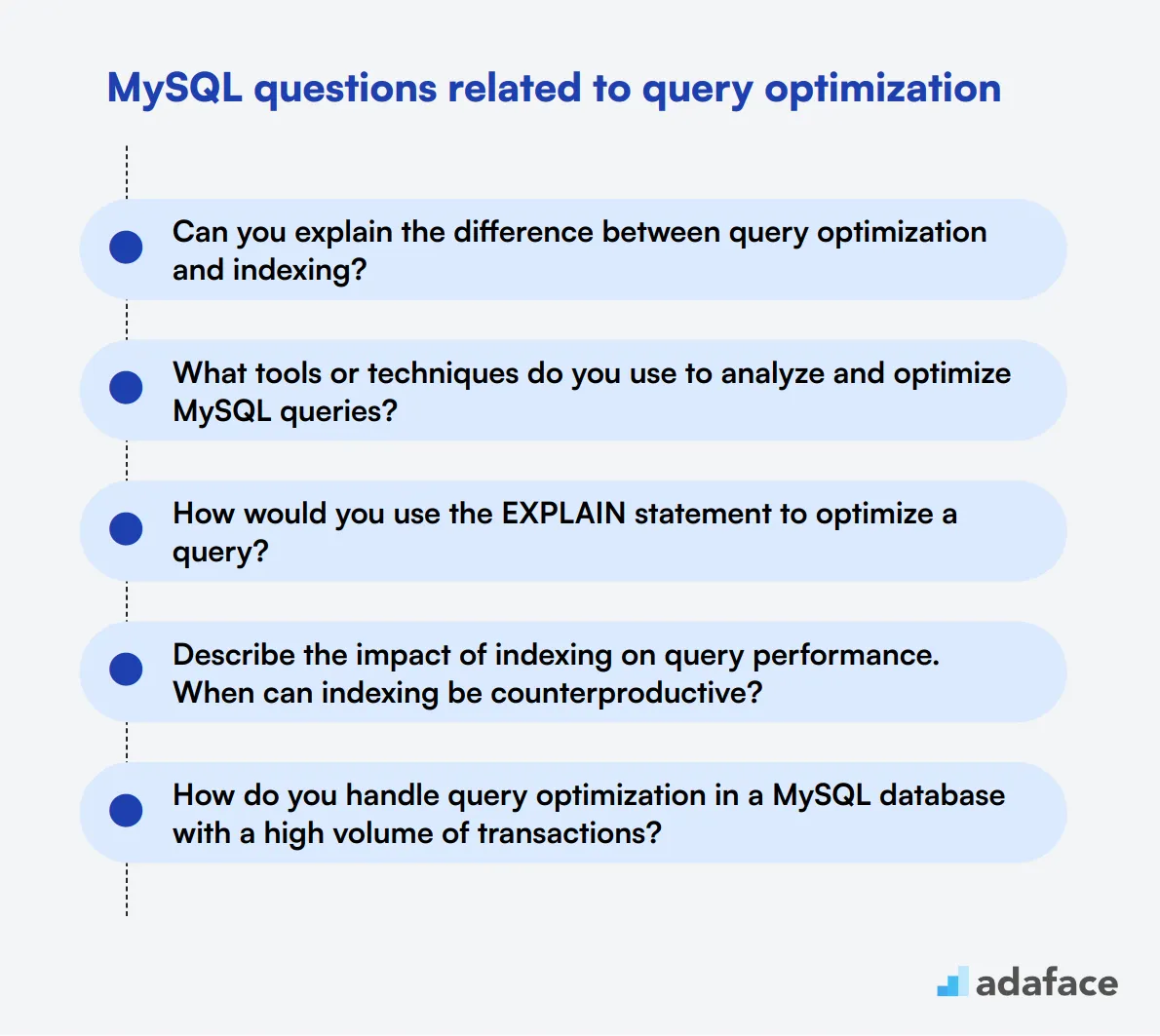
To determine if your candidates have the necessary skills to optimize MySQL queries efficiently, consider asking them these 12 MySQL query optimization interview questions. These questions are designed to reveal their understanding of performance tuning and their ability to work with large datasets, crucial skills for roles like database developer.
- Can you explain the difference between query optimization and indexing?
- What tools or techniques do you use to analyze and optimize MySQL queries?
- How would you use the EXPLAIN statement to optimize a query?
- Describe the impact of indexing on query performance. When can indexing be counterproductive?
- How do you handle query optimization in a MySQL database with a high volume of transactions?
- What are some common pitfalls you encounter during query optimization in MySQL?
- How would you optimize a MySQL database for write-heavy operations?
- Can you discuss the role of caching in MySQL query optimization?
- How do you determine which queries need optimization in a MySQL database?
- What strategies do you employ to reduce the load on a MySQL server?
- How would you optimize a query that involves multiple JOIN operations?
- Can you explain how partitioning can be used to improve query performance in MySQL?
8 MySQL interview questions and answers related to database design
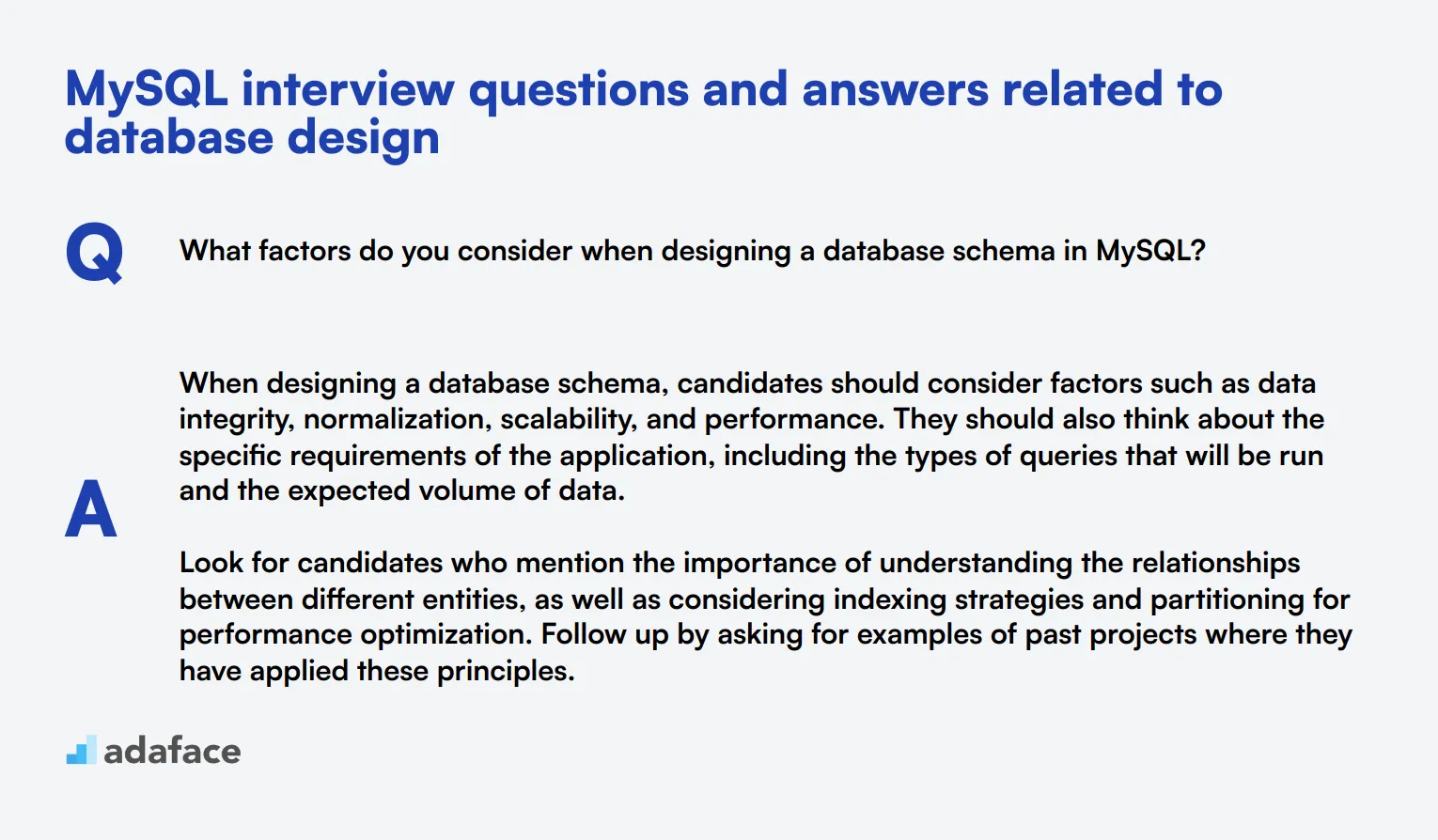
To evaluate whether candidates can effectively design and structure a MySQL database, ask them some of these insightful questions about database design principles. This will help you gauge their understanding of creating efficient and scalable database schemas.
1. What factors do you consider when designing a database schema in MySQL?
When designing a database schema, candidates should consider factors such as data integrity, normalization, scalability, and performance. They should also think about the specific requirements of the application, including the types of queries that will be run and the expected volume of data.
Look for candidates who mention the importance of understanding the relationships between different entities, as well as considering indexing strategies and partitioning for performance optimization. Follow up by asking for examples of past projects where they have applied these principles.
2. How do you ensure data integrity in a MySQL database?
Data integrity can be ensured through various methods including the use of primary keys, foreign keys, unique constraints, and check constraints. Additionally, implementing proper data validation in the application layer and using transactions to maintain consistency also contribute to data integrity.
Strong candidates will explain the importance of enforcing rules at the database level and may share experiences of how they have dealt with data integrity issues in the past. Look for a clear understanding of both declarative and procedural approaches to maintaining data integrity.
3. What is database normalization, and why is it important?
Database normalization is the process of organizing data in a database to reduce redundancy and improve data integrity. It involves dividing a database into smaller tables and defining relationships between them according to specific rules known as normal forms.
Normalization helps in minimizing duplicate data, ensuring consistent data, and making the database easier to maintain. However, it's important to strike a balance as over-normalization can sometimes lead to complex queries and decreased performance.
Candidates should be able to discuss the trade-offs of normalization vs. denormalization and provide examples of how they have applied these concepts in previous projects. Mention the importance of problem-solving skills in optimizing database schemas.
4. How do you approach indexing in MySQL to improve query performance?
Indexing is a technique used to speed up the retrieval of data from a database by creating a data structure that allows for faster searches. Common types of indexes include primary keys, unique indexes, and composite indexes.
Effective indexing requires an understanding of the types of queries that will be run and the specific columns that are frequently used in search conditions or join operations. Over-indexing can lead to increased maintenance costs and slower write operations.
Look for candidates who demonstrate a balanced approach to indexing, understanding both its benefits and potential downsides. They should also be able to share specific examples of how they have optimized indexing in their past work.
5. What strategies do you use for partitioning data in MySQL?
Data partitioning involves dividing a large database into smaller, more manageable pieces, known as partitions. This can improve performance and make maintenance easier. Common partitioning strategies include range partitioning, list partitioning, and hash partitioning.
The choice of partitioning strategy depends on the specific requirements of the application, such as the types of queries and the distribution of data. For example, range partitioning is useful for time-series data, while hash partitioning can help distribute data evenly across partitions.
Candidates should be able to discuss the pros and cons of different partitioning strategies and provide examples of how they have implemented them in past projects. Follow up by asking about the challenges they faced and how they overcame them.
6. How do you design a database to handle high read and write operations efficiently?
Designing a database to handle high read and write operations involves optimizing both the database schema and the underlying infrastructure. Strategies include using appropriate indexing, caching frequently accessed data, and implementing efficient query designs.
Additionally, using techniques such as vertical and horizontal scaling, database sharding, and load balancing can help distribute the load and improve performance. It's also important to regularly monitor and tune the database to address any performance bottlenecks.
Look for candidates who can discuss the trade-offs and challenges of different optimization techniques and provide examples of how they have successfully designed databases for high-traffic applications. Mention the importance of attention to detail in ensuring optimal performance.
7. What considerations do you make for database security during the design phase?
Database security should be a key consideration during the design phase. This includes implementing access controls, using encryption for sensitive data, and ensuring secure communication channels. Additionally, designing with the principle of least privilege in mind helps minimize the risk of unauthorized access.
Candidates should also consider regular security audits, vulnerability assessments, and staying updated with the latest security patches and best practices. Designing a robust backup and recovery plan is also crucial for ensuring data security.
Look for candidates who demonstrate a comprehensive understanding of database security and can provide examples of how they have implemented security measures in past projects. Follow up by asking about the specific tools and techniques they use for monitoring and maintaining database security.
8. How do you address scalability in MySQL database design?
Scalability in database design involves planning for growth in data volume and user load. This can be achieved through techniques such as vertical scaling (upgrading hardware), horizontal scaling (adding more servers), and database sharding (splitting data across multiple databases).
Candidates should consider factors such as data distribution, query patterns, and the need for real-time data access when designing for scalability. Implementing efficient indexing, caching, and partitioning strategies can also help manage large datasets and high traffic.
Look for candidates who can discuss the trade-offs and challenges of different scalability approaches and provide examples of how they have designed databases to handle growth. Mention the importance of learning agility in adapting to changing requirements and technologies.
Which MySQL skills should you evaluate during the interview phase?
While it’s challenging to assess every aspect of a candidate's capabilities in a single interview, focusing on specific MySQL skills can provide valuable insights. In this section, we will highlight the core MySQL competencies you should prioritize during the interview phase.
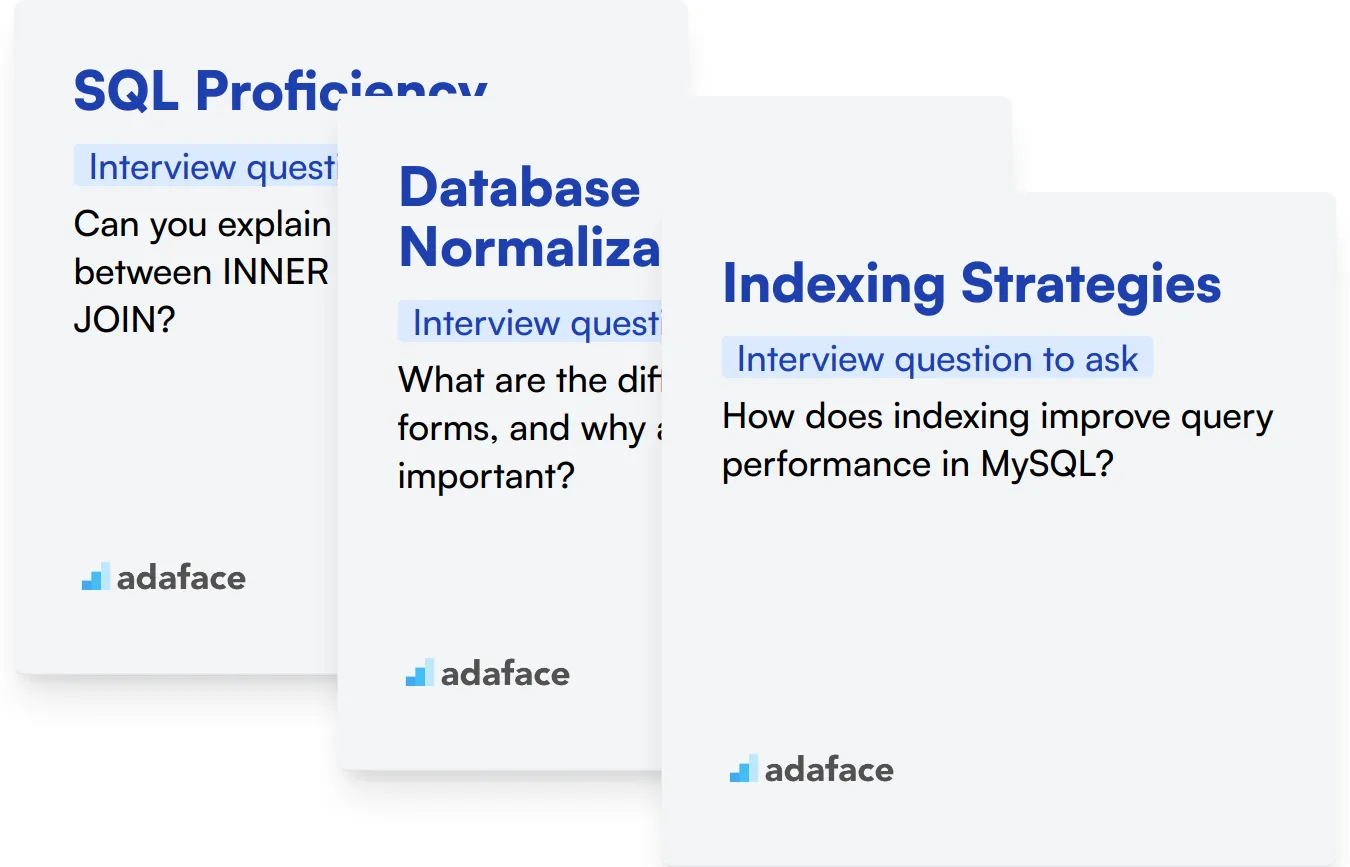
SQL Proficiency
To evaluate SQL proficiency, consider using an assessment test featuring relevant multiple-choice questions. You can find a suitable test in our library, such as the SQL Coding Assessment.
In addition to assessments, you can gauge a candidate's SQL skills by asking targeted interview questions. For instance,
Can you explain the difference between INNER JOIN and LEFT JOIN?
When asking this question, look for clarity in their explanation and understanding of how each join operates. A proficient candidate should describe how INNER JOIN returns only matching rows, whereas LEFT JOIN returns all rows from the left table and matching rows from the right table.
Database Normalization
To further assess this skill, you can ask candidates specific questions about normalization. For example,
What are the different normal forms, and why are they important?
Pay attention to their ability to articulate the various normal forms (1NF, 2NF, 3NF, BCNF) and explain how they contribute to database design and efficiency.
Indexing Strategies
You can employ an assessment test to probe indexing knowledge, such as our MySQL Online Test that includes questions about indexing strategies.
For deeper insights, consider asking candidates direct questions about indexing. A relevant question could be,
How does indexing improve query performance in MySQL?
Look for an explanation of how indexes reduce data scanning, enhance the speed of data retrieval, and the potential trade-offs involved with using too many indexes.
3 Tips for Effectively Using MySQL Interview Questions
Before you start putting your interview strategy into action, consider these tips to enhance your candidate assessment process.
1. Leverage Skills Tests Before Interviews
Using skills tests prior to interviews can significantly streamline your candidate selection process. These tests provide an objective measure of a candidate's proficiency with MySQL, helping you identify the most qualified applicants before you invest time in interviews.
Consider utilizing tests such as the MySQL Online Test or the SQL Coding Test to assess candidates' technical abilities. By evaluating their skills upfront, you can focus on candidates who not only meet the technical requirements but also align with your team’s needs.
Integrating these tests into your hiring process allows you to filter candidates effectively, ensuring that those who advance to the interview stage have the necessary MySQL skills. This approach sets a solid foundation for deeper discussions during the interview.
2. Curate Targeted Interview Questions
With limited time for interviews, choosing the right questions is essential for effective candidate evaluation. Focusing on a few targeted questions related to MySQL will help you assess critical skills without overwhelming the interview process.
Consider integrating questions from related fields, like PostgreSQL or SQL Server, to gauge adaptability and versatility in database management. Soft skills, such as communication and teamwork, are also important, so don’t overlook those aspects.
Strategically selecting your questions ensures that you’re evaluating candidates on the most important fronts, making each interview more productive and focused on the skills that matter.
3. Incorporate Follow-Up Questions
Simply relying on initial interview questions may not reveal the true depth of a candidate's knowledge. Follow-up questions are crucial for probing deeper into their understanding and capabilities, helping to uncover any superficial responses or gaps in knowledge.
For example, if a candidate states they can optimize a query, a good follow-up could be, 'Can you explain how indexing would affect performance in this scenario?' This encourages candidates to elaborate and demonstrates their problem-solving skills and practical knowledge.
Use MySQL interview questions and skills tests to hire talented developers
If you are looking to hire someone with MySQL skills, you need to ensure they have those skills accurately. The best way to do this is to use skill tests. Check out our MySQL Online Test or our SQL Online Test.
Once you use this test, you can shortlist the best applicants and call them for interviews. To get started, you can sign up here or explore our online assessment platform.
MySQL Online Test
Download MySQL interview questions template in multiple formats
MySQL Interview Questions FAQs
Include general questions, junior and mid-tier developer questions, query optimization questions, and database design questions to assess a wide range of skills.
Prepare a mix of questions based on the candidate's experience level. Our post provides 55 questions across different categories and difficulty levels.
Yes, our post includes 12 MySQL questions specifically related to query optimization to help you evaluate candidates' skills in this area.
Combine interview questions with skills tests, tailor questions to the job role, and use a mix of theoretical and practical questions to thoroughly assess candidates.

40 min skill tests.
No trick questions.
Accurate shortlisting.
We make it easy for you to find the best candidates in your pipeline with a 40 min skills test.
Try for freeRelated posts
Free resources




